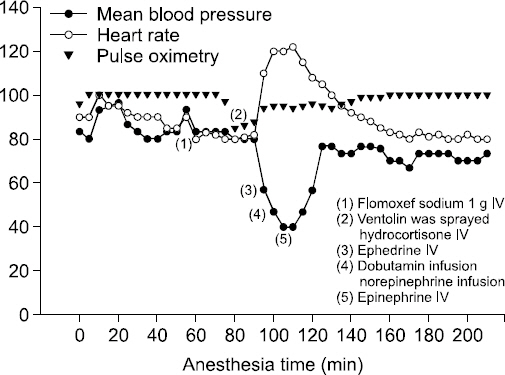Anesth Pain Med.
2016 Jul;11(3):260-263. 10.17085/apm.2016.11.3.260.
Anaphylactic shock caused by an intradermal skin test-negative antibiotic during general anesthesia: A case report
- Affiliations
-
- 1Department of Anesthesiology and Pain Medicine, Hanyang University Hospital, Seoul, Korea. dongwkim@hanyang.ac.kr
- KMID: 2344928
- DOI: http://doi.org/10.17085/apm.2016.11.3.260
Abstract
- Anaphylaxis during the perioperative period is rare, but it still causes severe cardiovascular and respiratory collapse that can be fatal. In particular, when using antibiotics that have a high risk of hypersensitivity reactions, it is important to establish that intradermal skin tests are negative before using antibiotics. We report a case of anaphylactic shock occurring during general anesthesia after using an intradermal skin test-negative antibiotic. Regrettably, negative results of intradermal skin tests before using antibiotics do not completely eliminate the risk of anaphylaxis. Therefore, anesthesiologists should be prepared for anaphylaxis to occur at any point during the perioperative period.
MeSH Terms
Figure
Cited by 2 articles
-
Anaphylaxis occurred immediately after prophylactic antibiotics injection with negative intradermal skin test during laparoscopic cholecystectomy
Hyung Joo Jeong, Hsi Chiang Kung, Tae Woo Park, Dong Hee Kang, Yu Som Shin, Ju Deok Kim
Kosin Med J. 2018;33(2):245-251. doi: 10.7180/kmj.2018.33.2.245.Hypersensitivity Reaction to Perioperative Drug Mistaken for Local Anesthetic Systemic Toxicity in a Patient under Brachial Plexus Block
Jee Young Jun, Youn Jin Kim, Jong Hak Kim, Jong In Han
Kosin Med J. 2018;33(3):468-476. doi: 10.7180/kmj.2018.33.3.468.
Reference
-
1. Brown SG, Mullins RJ, Gold MS. Anaphylaxis: diagnosis and management. Med J Aust. 2006; 185:283–9. PMID: 16948628.2. Mertes PM, Alla F, Tréchot P, Auroy Y, Jougla E. Anaphylaxis during anesthesia in France: an 8-year national survey. J Allergy Clin Immunol. 2011; 128:366–73. DOI: 10.1016/j.jaci.2011.03.003. PMID: 21497888.3. Soetens FM, Smolders FJ, Meeuwis HC, Van der Donck AG, Van der Aa PH, De Vel MA, et al. Intradermal skin testing in the investigation of suspected anaphylactic reactions during anaesthesia--a retrospective survey. Acta Anaesthesiol Belg. 2003; 54:59–63. PMID: 12703347.4. Ebo DG, Fisher MM, Hagendorens MM, Bridts CH, Stevens WJ. Anaphylaxis during anaesthesia: diagnostic approach. Allergy. 2007; 62:471–87. DOI: 10.1111/j.1398-9995.2007.01347.x. PMID: 17441788.
Article5. Lienhart A, Auroy Y, Péquignot F, Benhamou D, Warszawski J, Bovet M, et al. Survey of anesthesia-related mortality in France. Anesthesiology. 2006; 105:1087–97. DOI: 10.1097/00000542-200612000-00008. PMID: 17122571.
Article6. Ewan PW, Dugué P, Mirakian R, Dixon TA, Harper JN, Nasser SM. BSACI guidelines for the investigation of suspected anaphylaxis during general anaesthesia. Clin Exp Allergy. 2010; 40:15–31. DOI: 10.1111/j.1365-2222.2009.03404.x. PMID: 20205694.
Article7. Krishna MT, York M, Chin T, Gnanakumaran G, Heslegrave J, Derbridge C, et al. Multi-centre retrospective analysis of anaphylaxis during general anaesthesia in the United Kingdom: aetiology and diagnostic performance of acute serum tryptase. Clin Exp Immunol. 2014; 178:399–404. DOI: 10.1111/cei.12424. PMID: 25070464. PMCID: PMC4233389.
Article8. Zheng X, Fang X, Cai X. Two episodes of anaphylaxis caused by a chlorhexidine sulfadiazine-coated central venous catheter. Chin Med J (Engl). 2014; 127:2395–7.9. Yang CS, Koo MS, Kwak HS, Lee MA, Lee HH. Vancomycin-induced hypersensitivity reaction with slow infusion. Anesth Pain Med. 2008; 3:183–5.10. McKinnon RP, Wildsmith JA. Histaminoid reactions in anaesthesia. Br J Anaesth. 1995; 74:217–28. DOI: 10.1093/bja/74.2.217.
Article11. Terico AT, Gallagher JC. Beta-lactam hypersensitivity and cross-reactivity. J Pharm Pract. 2014; 27:530–44. DOI: 10.1177/0897190014546109. PMID: 25124380.
Article12. Rank MA, Park MA. Anaphylaxis to piperacillin-tazobactam despite a negative penicillin skin test. Allergy. 2007; 62:964–5. DOI: 10.1111/j.1398-9995.2007.01418.x. PMID: 17620077.
Article13. Torres MJ, Blanca M, Fernandez J, Romano A, Weck A, Aberer W, et al. Diagnosis of immediate allergic reactions to beta-lactam antibiotics. Allergy. 2003; 58:961–72. DOI: 10.1034/j.1398-9995.2003.00280.x. PMID: 14510712.
Article14. Alonso Díaz de Durana MD, Fernández-Rivas M, Casas ML, Esteban E, Cuevas M, Tejedor MA. Anaphylaxis during negative penicillin skin prick testing confirmed by elevated serum tryptase. Allergy. 2003; 58:159. DOI: 10.1034/j.1398-9995.2003.00056_2.x. PMID: 12622750.
Article15. Lee KH, Lim HK, Park JH, Do HJ, Jeon YG. Suspected anaphylactic reaction prior to induction of anesthesia. J Lifestyle Med. 2015; 5:26–9. DOI: 10.15280/jlm.2015.5.1.26. PMID: 26528427. PMCID: PMC4608229.
Article
- Full Text Links
- Actions
-
Cited
- CITED
-
- Close
- Share
- Similar articles
-
- Anaphylaxis occurred immediately after prophylactic antibiotics injection with negative intradermal skin test during laparoscopic cholecystectomy
- Hypersensitivity Reaction to Perioperative Drug Mistaken for Local Anesthetic Systemic Toxicity in a Patient under Brachial Plexus Block
- Anaphylactic shock after sugammadex administration, induced by formation of a sugammadex-rocuronium complex: a case report
- Anaphylactic shock caused by intramuscular injection of midazolam during the perioperative period: a case report
- Chlorhexidine Anaphylaxis after Urethral Catheterization during Anesthesia : A case report


